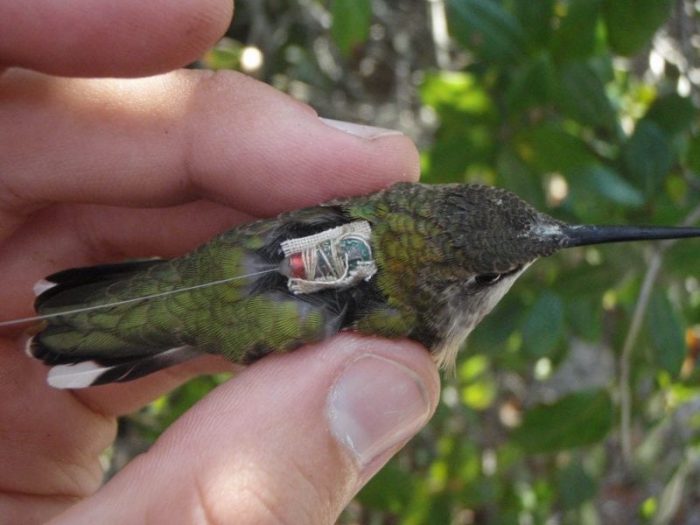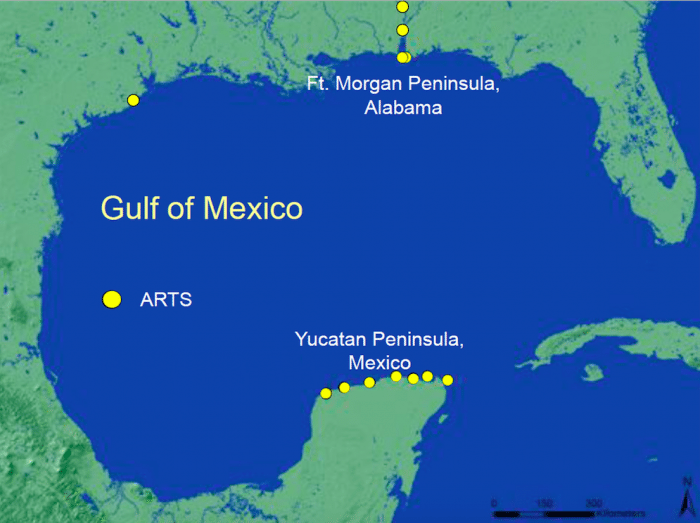
Many people find it hard to believe that the small, backyard birds encountered during particular seasons travel thousands of kilometers between temperate breeding grounds and tropical wintering areas. Even more surprising is that temperate-breeding hummingbirds, which can weigh as little as 3 grams or ¾ teaspoon of sugar, make remarkable journeys from the United States and Canada to Central America and Mexico every autumn.
The Ruby-throated Hummingbird (Archilochus colubris), the only hummingbird that breeds in eastern North America, not only makes these incredible long-distance migrations but must also negotiate crossing the Gulf of Mexico – a 1,000 kilometer non-stop flight. To contend with such challenges, Ruby-throated Hummingbirds are capable of doubling their mass to 6 grams by accumulating fat stores before initiating migratory flight. However, despite the awe and wonder these colorful, little birds inspire, only anecdotal evidence and theoretical flight models have suggested hummingbirds may be crossing the Gulf of Mexico.
It is only recently that the miniaturization and advancement of radio telemetry tags in the field of wildlife tracking are produced small enough (~ 0.2 grams) to be outfitted for hummingbirds (Figure 1). Taking advantage of these miniaturized tags and the use of an international network of automated radio telemetry stations (Figure 2) allowed an investigation of the migratory routes and decisions made by juvenile Ruby-throated Hummingbirds on their autumn migration.

Figure 1. Ruby-throated Hummingbird with a radio transmitter. Photograph by T.J. Zenzal.

Figure 2. International network of automated radio telemetry systems (ARTS) around the Gulf of Mexico. Credit: Theodore J. Zenzal Jr
Studying juvenile migratory birds in autumn is especially interesting since these individuals just hatched a month or two before making their first solo, long-distance flight across international borders to wintering locations they have never visited. Given their inexperience, the endogenous migratory program can be investigated in relation to conditions experienced en route, which includes potential ecological barriers like the Gulf of Mexico.
While some migratory birds are able to make spectacular, non-stop, long-distance flights from breeding location to wintering destination, many others elect to stop along the way where they can rest and refuel. For hummingbirds, these “stopover sites” tend to vary between years and consequently place individuals in unfamiliar habitats.
Ruby-throated Hummingbirds were captured at a stopover site within the Bon Secour National Wildlife Refuge on the Fort Morgan Peninsula in coastal Alabama, USA, between 2011 and 2014, which represents a potential last stop before crossing the Gulf of Mexico. During this time, 2,272 Ruby-throated Hummingbirds were captured and 55 of those individuals received a radio transmitter before being released (Figure 1). Radio transmitter frequencies were monitored in Alabama and Texas, USA as well as along the northern coast of the Yucatan Peninsula, Mexico, which represents the shortest flight path over the Gulf from Alabama (Figure 2).
The data obtained from the automated radio telemetry systems showed that most hummingbirds (83%) departed coastal Alabama during the morning hours, which is in contrast to the departure time of many songbirds that tend to make migratory flights overnight. Departure time was influenced by the amount of time a bird spent at the stopover site: individuals that spent at least one night at the site tended to leave in the morning, whereas birds departing the same day of capture tended to leave during the afternoon or evening.
Upon departure, the majority of birds (77%) oriented essentially parallel to the coastline with an east or west heading, rather than south over the Gulf of Mexico. No other factors, such as fuel load or weather that are important in departure decisions for many species of nocturnally migrating songbirds, influenced a hummingbird’s departure direction. No hummingbirds were detected on automated radio telemetry systems outside of Alabama, but one radio-tagged hummingbird was observed at a hummingbird feeder in Corpus Christi, TX two weeks after being captured in coastal Alabama, a distance of ~1,000 kilometers. Additionally, bird banding data from coastal Alabama and the Yucatan Peninsula shows that Ruby-throated Hummingbirds do not arrive in Yucatan until almost a month after the majority have departed Alabama, which supports a longer circum-Gulf route.
These outcomes suggest that juvenile hummingbirds resuming migratory flight in coastal Alabama move around the Gulf of Mexico rather than across during autumn. The departure time and direction is also consistent with a fly-and-forage strategy in which hummingbirds take advantage of flowers and hummingbird feeders along the coast while progressing toward their wintering destination. While adult hummingbirds were not radio-tracked, less than 100 were captured on the Alabama coast. Having made this trip previously, adults likely elected to depart from habitats further inland – overflying the coast if going across the Gulf or taking a more direct route towards Texas if flying around the Gulf.
These findings underpin the importance of coastal-forested habitats, which are impacted by human development as well as natural or anthropogenic disturbances (e.g., hurricanes and oil spills). The conservation of not only hummingbirds but almost all migratory birds rests crucially on their ability to rest and refuel in coastal habitats.
These findings are described in the article entitled Migratory hummingbirds make their own rules: the decision to resume migration along a barrier, recently published in the journal Animal Behaviour. This work was conducted by Theodore J. Zenzal Jr from the University of Southern Mississippi and the University of Illinois at Urbana-Champaign, Frank R. Moore from the University of Southern Mississippi, Robert H. Diehl from the U.S. Geological Survey Northern Rocky Mountain Science Center, Michael P. Ward from the University of Illinois at Urbana-Champaign, and Jill L. Deppe from Eastern Illinois University.









